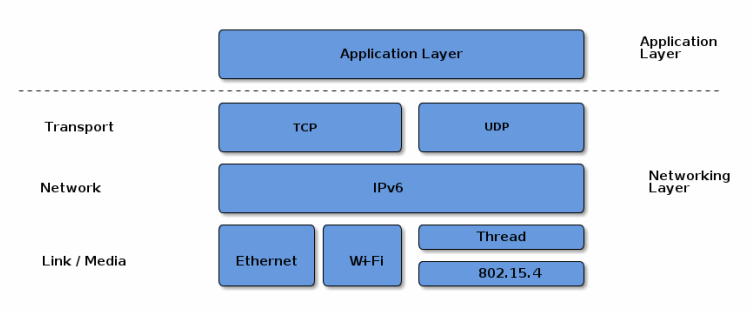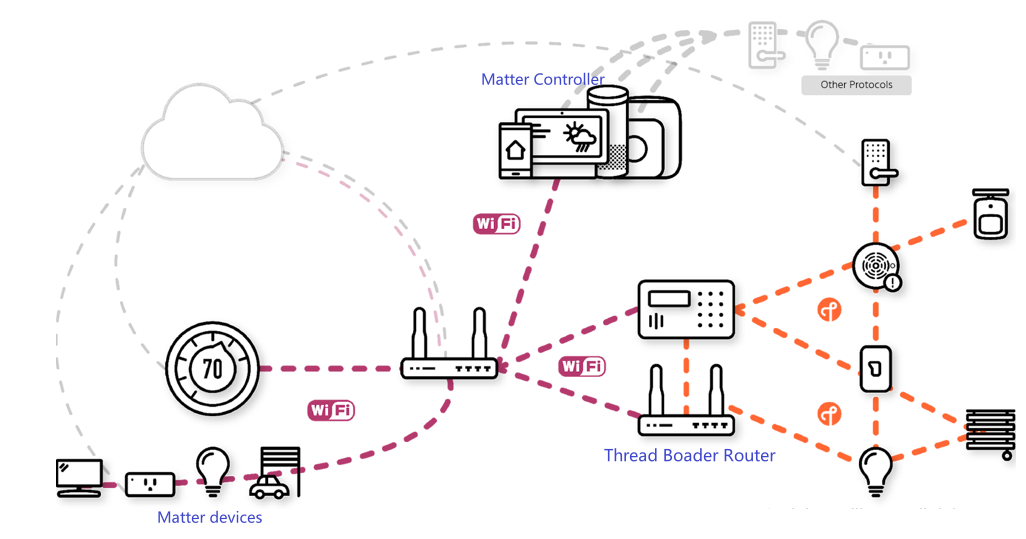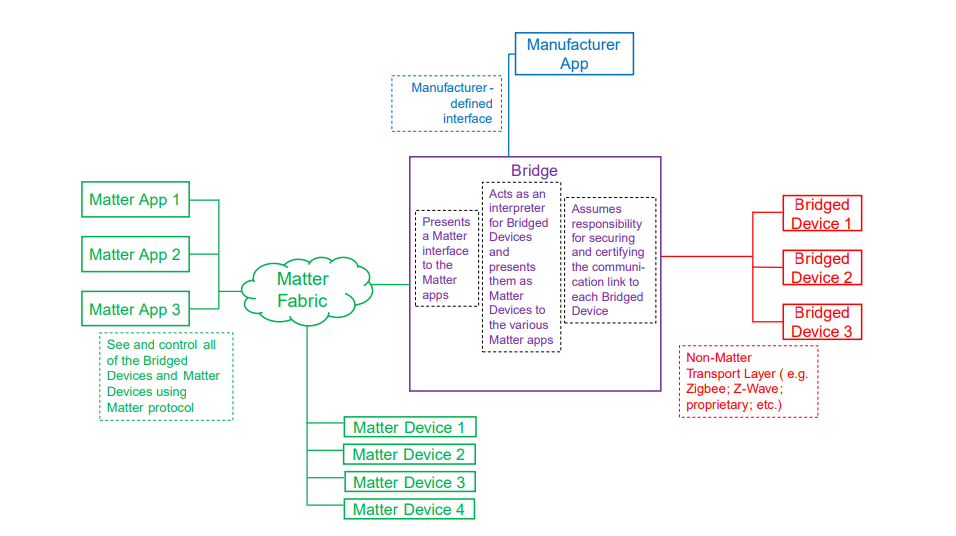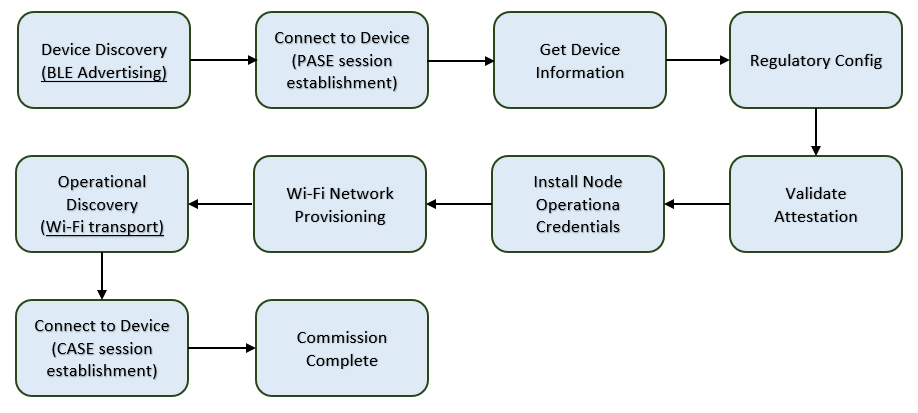What is Matter
In the current market for smart homes and intelligent buildings powered by the Internet of Things (IoT), there exists a fragmented landscape due to the proliferation of diverse technical standards and proprietary ecosystems, often referred to as “walled gardens.” Consumers face multiple considerations when purchasing smart devices: whether their preferred products are compatible with their existing home systems, future maintenance needs, and scalability, among other factors. Meanwhile, manufacturers looking to expand their product reach into various markets are compelled to repeatedly develop the same product to ensure compatibility with different platforms and ecosystems. This necessitates a considerable investment in adapting their offerings to bridge these interoperability gaps.
Matter was developed by a Working Group within the Connectivity Standards Alliance (Alliance). This Working Group develops and promotes the adoption of the Matter standard, a royalty-free connectivity standard to increase compatibility among smart home products, with security as a fundamental design tenet. The vision that led major industry players to come together to build Matter is that smart connectivity should be simple, reliable, and interoperable.It is built with market-proven technologies using Internet Protocol (IP) and is compatible with Thread and Wi-Fi network transports.
The Matter technology encompasses three specification documents, which are:
Matter Core Specification : The Core Standard constitutes the main body of specifications, defining the Matter protocol architecture, secure communication mechanisms, provisioning processes, data models, and other essential Matter technology components.
Matter Application Cluster Specification : The detailed definitions of clusters related to Matter product applications.
Matter Device Library Specification: The detailed definitions for currently supported Matter device categories include, for instance, the necessity for devices to meet specific cluster requirements.
They are all available for download on the CSA .
Matter Architecture Overview
Matter aims to build a universal IPv6-based communication protocol for smart home devices.The protocol defines the application layer that will be deployed on devices as well as the different link layers to help maintain interoperability.The following diagram illustrates the normal operational mode of the stack:

Application and Network Stack
The architecture is divided into layers to help separate the different responsibilities and introduce a good level of encapsulation among the various pieces of the protocol stack. The vast majority of interactions flow through the stack captured in the following Figure:

分层架构
Application High-order business logic of a device. For example, an application that is focused on lighting might contain logic to handle turning on/off the bulb as well as its color characteristics.
Data Model The data layer corresponds to the data and verb elements that help support the functionality of the application.The Application operates on these data structures when there is an intent to interact with the device.
Interaction Model The Interaction Model layer defines a set of interactions that can be performed between a client and server device. For example, reading or writing attributes on a server device would correspond to application behavior on the device. These interactions operate on the elements defined at the data model layer.
Once an action (action) is constructed using the Interaction Model, the action will be serialized into a compact binary format as specified, ready for encoding and transmission over the network. This process is handled within the Action Framing layer.
After the encoded action frame is processed, it undergoes further handling at the Security Layer where the message is encrypted and a message authentication code is appended. These procedures ensure both the confidentiality and authenticity of the data exchanged between the sender and receiver of the messages.
When the interaction is serialized, encrypted, and signed, the Message Layer constructs the payload format with mandatory and optional header fields, where these header fields specify properties of the message along with its logical routing information.
After the payload has been constructed by the Message Layer , it is then transmitted using an IP-based data transfer protocol, either TCP or Matter’s own Message Reliability Protocol (MRP). This ensures the reliable and efficient delivery of the packaged data across the network.
After the data is received by the peer device, the data stream moves upward through the protocol stack, essentially reversing the operations performed on the data by the sender at each layer, with the ultimate goal of delivering the message to the application.
Beyond the process of data movement through the protocol stack, Matter encompasses the definition of security mechanisms such as the establishment of secure sessions using Operational Certificates within its Certificate Authenticated Session Establishment (CASE) framework, alongside Passcode-Authenticated Session Establishment (PASE) for initial setup and authentication. Moreover, it incorporates support for group communications and implements a Bulk Data Exchange Protocol (BDX) specifically tailored for transferring large amounts of data during Over-the-Air (OTA) software updates. Additionally, Matter allows for the adoption of vendor-specific transport protocols.
Matter network example
In the Matter ecosystem, the topology supports simultaneous operation across Wi-Fi, Thread, and Ethernet networks, which means that Matter enables seamless interoperability between devices from different network technologies. Specifically, through a Thread Border Router, it facilitates communication between Wi-Fi and Thread devices. Furthermore, Matter also allows the integration of other networked devices like ZigBee devices, typically achieved via a Matter Bridge device that serves as an intermediary for protocol translation.A key component in the Matter topology is the Matter Controller node. The Matter Controller plays a crucial role in provisioning new devices onto the network and managing remote control of these devices. For example, Apple’s HomePod mini and the Home app serve as a typical instance of a Matter controller node, orchestrating the configuration and operation of connected Matter devices.:

拓扑结构
Matter network concept
Matter Device
A smart home hardware product that supports Matter, so that it can be connected to and controlled by a Matter Controller. Examples: light bulbs, switches, sensors, thermostats, blinds, door locks, bridges, and media devices.
Matter Commissioner
A device or application that is used as a tool to set up a Matter Device, in other words bring it into a Matter Fabric. Commissioners first verify the device’s authenticity and then assign network credentials as needed. A platform, device vendor, or other Matter-enabled app, mobile OS, smart speaker, or display may all provide a Matter Commissioner. A Commissioner can be an independent tool or part of a device or system that includes other roles such as Administrator or Controller,for example iOS Home app,Google Home,Alexa app。
Matter Controller
a Matter Controller is an entity that can control Matter devices the user has connected to it. Matter Controller functionality can be built into many types of hardware devices like phones, always-powered smart home hubs that provide local and remote control, smart switches and buttons, or even mobile apps. There can be multiple Matter Controllers on a Fabric to provide redundancy and/or convenient controls for users. for example, iOS Home app or HomePod.
Matter Administrator
A device or application that creates, maintains, and manages security and privileges for all devices on the Fabric it administers. Administrators can be a physical device like a hub or software like an app. Matter’s Multi-Admin feature which allows Devices to connect to multiple smart home platforms simultaneously, is a reference to connecting Devices to multiple Matter Administrators, and thus to multiple Fabrics.for example iOS Home App,Google Home App,Alexa App.
Matter Fabric
Matter Devices are connected together on a virtual network within the home called a Matter Fabric, a private virtual network over which Matter Devices, Admins, and Controllers communicate with each other. Matter Fabrics can span across the Wi-Fi, Thread, and Ethernet physical networks within the home. Matter Devices can be connected to one or more Fabrics at a time, each managed by a Matter Administrator. Within the fabric, each node is uniquely identified by a stable Node ID.
Matter bridge
A Bridge serves to allow the use of non-Matter IoT devices (e.g. devices on a Zigbee or Z-Wave network, or any other non-Matter connectivity technology) in a Matter Fabric, with the goal to enable the consumer to keep using these non-Matter devices together with their Matter devices.

Matter Bridge
Matter OTA
The Matter specification mandates that devices must support a firmware upgrade capability; however, while Matter defines a comprehensive set of standards for device upgrades, it does not strictly require that devices adhere only to the OTA upgrade method prescribed by Matter. This implies that devices are allowed to utilize alternative methods for upgrading, such as those based on Bluetooth or Wi-Fi.
Within the Matter standard’s OTA framework, two roles are defined: the OTA Provider and the OTA Requestor. Both the OTA Provider and the OTA Requestor are clusters, meaning they can function either as clients or servers. A device seeking to upgrade its firmware is referred to as the OTA Requestor, whereas the device providing the firmware update (for example, a controller) is designated as the OTA Provider.
Distributed Compliance Ledger(DCL)
DCL operates as a distributed database managed by CSA, functioning akin to a ledger that continually evolves and updates. Whenever member companies introduce new products, they record the certification information of these products into the DCL. If a new PAA (Product Attestation Authority) certificate is issued, this information too gets written into the DCL. In the context of the Matter standard’s OTA, URLs for new firmware images can also be recorded within the DCL. The CSA has the ability to revoke or invalidate certain certificates or certification details within the DCL if necessary.
In summary, DCL serves as a distributed database server that ensures the smooth operation of a Public Key Infrastructure (PKI) system, and simultaneously guarantees the interoperability among various ecosystems within the Matter standard.
Certificate Declaration(CD)
Whenever a product passes Matter certification, CSA issues a CD (Certification Declaration) certificate to it, which includes details such as Vendor ID, Certificate ID, and certification type. Given that all devices within a product category share the same CD and constant, the CD is typically hardcoded into the application.
Matter Commissioning
Matter commissioning refers to the process of integrating a device into a Matter Fabric, also known as a Matter operational network, which involves two key roles:
Commissioner device,This role is assumed by another device or service responsible for guiding the commissionee through the process. The commissioner verifies the device’s identity, provisions appropriate credentials, and sets up the necessary network and security parameters to ensure seamless integration and interoperability within the Matter network.
Commissionee device,This role is played by the device being added to the Matter network.
To initiate the commissioning process, the commissionee must provide the following onboarding information:
16-bit Vendor ID and 16-bit Product ID
12-bit device discriminator
27-bit setup passcode
8-bit Discovery Capabilities Bitmask
The above information can be provided in the following three ways:
Manual Pairing Code
QR Code
QR Code Payload
Device must support Manual Pairing Codes, but the use of QR codes is recommended.
The commissioning process is illustrated as follows in the diagram below:

Matter配对流程
f the provisioning process described above is successful, the device will obtain the following information:
An Instance Name composed of the Fabric ID and Node ID
Node Operational Certificate(NOC)
The corresponding private key for the NOC
Access Control List
Other pertinent information about the operational network
Data Model and Device Type
The following represents a typical data model for a Matter device:

Data Model
Fabric
In the same Fabric, devices share a common root certificate, and through the validation of the certificate chain, all devices within the same Fabric can establish secure communication.
Node
A Node is a logically independent device with a unique network address. Each Matter device comprises one or more Nodes.
Endpoint
A Node contains multiple Endpoints, each of which is a logically independent functional module. For example, a smart lock can consist of not only an endpoint for the lock function itself, but also an endpoint for a temperature sensor.
Note
Endpoint 0 is reserved for Matter’s utility clusters and is mandatorily included in every Matter device.
Cluster
An Endpoint is composed of one or more Clusters, which can be thought of as a basic set of functionalities. Each Cluster contains three components: Attributes, Commands, and Events. For instance, continuing with the example of a door lock Endpoint, aside from housing a cluster for lock/unlock functionality, it could also include an alarm cluster to enable alarm features.
Matter defines two types of Clusters:
Server – Provide Attributes, Commands and Events
Client – Initiates interactions with the Server
The detailed specifications of Clusters are outlined in the Matter Application Cluster Specification. How Clusters are assembled to form Endpoints, and subsequently, how these Endpoints compose device types, is governed by the Matter Device Library Specification.
Attribute
Attributes are individual data records that represent physical quantities or states, stored within the memory of a device.
Command
A Command, as mentioned later as an ‘action’, is used to trigger a specific behavior on the server side, such as a lock command that initiates the locking operation.
Event
An Event can actually be considered a special type of Attribute, as it is used to update the state of a device. Therefore, one could regard an Event as a historical data record.
Interaction Model
The Interaction Model specifies the set of interaction commands. We call the node initiating an interaction the initiator (usually a client device), while the receiving end is termed the target (generally a server device).
Matter defines the following types of interactions:
Read
This is used to retrieve the value of attributes or events.
Write
This is employed to modify the value of an attribute.
Invoke
This is utilized to send commands.
Subscribe
This interaction type allows subscribing to data reports from the target, eliminating the need for periodic querying of data. You can subscribe to both attributes and events, thus receiving updates automatically when their values change.